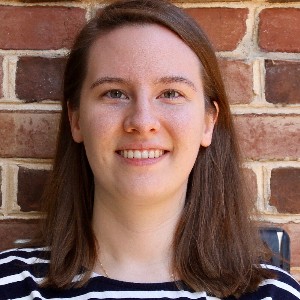Mary Rooney Completes Ph.D. Dissertation Defense
Summary
The Applied Science Department would like to officially congratulate Dr. Mary Rooney on successfully defending her Ph.D. Dissertation.
Full Description

Mary Rooney received a BS in Chemistry and Mathematics and a BA in Classical Languages and
Literatures from Hofstra University in 2016. She completed an MS in Chemistry at William & Mary in
2018, specializing in physical chemistry. For the past four years, she has been conducting doctoral
research in the area of biophysical chemistry under the direction of Dr. Myriam Cotten, focusing on
structure-function relationships of the host defense peptides piscidins 1 and 3. She will be joining the
faculty of chemistry at Hofstra University in Fall 2022 as a Special Assistant Professor.
DissertationTitle: Metal-ion binding in the antimicrobial peptides piscidins 1 and 3: Insights into the molecular structures of metallopeptides and their mechanisms of membrane disruption.
Abstract: The host defense peptides piscidin 1 and 3, (P1 and P3), isolated from the mast cells of hybrid striped bass, are antimicrobial metallopeptides that destroy several types of pathogens, including E. coli, as well as some tumor cells. Studies suggest that each peptide has a preferred method of attack: P1 disrupts cell membranes and P3, while still exhibiting a lesser degree of membrane-disrupting abilities, also damages DNA. However, these mechanisms are not yet well characterized. Biological assays testing the bactericidal activity of P1 and P3 in both the metallated and apo states have shown that the peptides have a greater bactericidal effect when metal-bound; therefore understanding structural changes that occur in the peptides upon Cu (II) or Ni (II) binding is an important first step in elucidating the mechanisms by which they function. Once the peptide structures are refined, we can more accurately probe the peptides’ interactions with cell membranes and other intracellular targets. We hypothesize that when a Cu (II) or Ni (II) ion binds the ATCUN motif at a peptide’s amino terminus, the peptide terminus becomes more ordered in addition to losing a positive charge. It then adopts a conformation that can insert more deeply into and disrupt the cell membrane of a pathogenic cell. To test this hypothesis, we use a combined experimental and computational approach to determine accurate structures of the ATCUN motif conformation of P1 and P3, as well as other mutated variations of their ATCUN motifs. We also study the structures and interactions of the full-length metallated peptides with membrane mimics of varying lipid compositions. It is hoped that by gaining insight into these peptides’ mechanisms of action, the
information can be used in informing novel drug designs to aid in the fight against multiple drug resistant”superbugs”.
Congratulations Dr. Rooney!
 Skip to main content
Skip to main content
